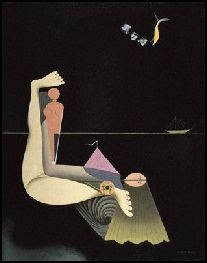Woman Sitting on the Veranda
oil on canvas, 73.0×91.0 cm
oil on canvas, 73.0×91.0 cm
Flowers. c. 1925
oil on canvas, 73.0×61.0 cm
The Moon and Flowers. 1926
oil on canvas, 91.0×117.0 cm
The National Museum of Modern Art, Tokyo
oil on canvas, 91.0×117.0 cm
The National Museum of Modern Art, Tokyo
Harbor, 1926
watercolor and pencil on paper, 49.2×62.1 cm
watercolor and pencil on paper, 49.2×62.1 cm
Summer Mountains. 1927
oil on canvas
Fireworks. 1927
oil on canvas
Fireworks. 1927
oil on canvas
Innocent Moonlit Night. 1929
oil on canvasSea. 1929
oil on canvas, 130.0×162.5 cm
Graceful Landscape, 1930
watercolor and pencil on paper, 22.7×25.8 cm
Make-up outside the Window. 1930
The Museum of Modern Art, Kamakura; Hayama
The Museum of Modern Art, Kamakura; Hayama
Endless flight. 1930
Oil on canvas Being, 1933
watercolor and pencil on paper, 23.8×32.8 cm
Koga's illustrations from Kodomo no kuni [Children's Land] (journals for children founded and published in 23 volumes and 265 issues from January1922 to March 1949.)
Early Summer Scene / "Kodomo no kuni" 1932
April Walk. 1932
May Motifs. 1932
Merry May. 1932
Mid-winter Night's Dream. 1931
Winter. 1932
Harue Koga was born the son of a Buddhist priest in the city of Kurume, Fukuoka prefecture in 1895. Hoping to become an artist he went to Tokyo to join the Taiheiyo Gakai Kenkyujo (Pacific Art Society Institute) in 1912. The next year, he entered the Nihon Suisaiga Kenkyujo (Japan Watercolor Painting Research Institute), where he studied under Ishii Hakutei. His works were selected for Taiheiyo Gakai and Suisaiga exhibitions. In 1915 he returned in Fukuoka and entered the priesthood. His sketches and postcard pictures in those days reveal the influence of the style of Takehisa Yumeji. In 1919 he was deeply moved at Takehisa's exhibition "for women and children." In 1920 he studied religious tone by imitating frescos by Cézanne and Renaissance artists. He was awarded the Nika prize for "Maiso" [Burial]. From around that time, his works began to exhibit elements of abstract expression such as that of Picasso and Laurencin. In October that year he organized the avant-garde society, Action, with more than ten artists, including Kanbara Tai. The society was dissolved not long after, and Koga began producing surrealistic works under the influence of Paul Klee. From 1927 to 1930 he became interested in commercial art, undertaking various poster making and bookbinding jobs. (Source)
.
.


















